Blockchain is essential for digital transformation. There is no other technology on the horizon that is decentralized, fault-tolerant, secure, and reliable for inter-Enterprise Master Data Management.
The popularity of Blockchain – decentralized ledger
technology underlying cryptocurrencies – is becoming a de-facto solution for
many peer-to-peer applications. Its growth is impressive, and the prediction is
a 67.3%
CAGR from 2020-2025, for a total of USD 39.7 Billion by 2025.
Blockchain is very much a revolution. It is the engine that
empowers the emergence of the Internet of Value. The speed of the exchange
of value has tremendous implications in many applications: for consumers,
industries, and governments. It is not just monetary value. It is also valuable
in the exchange of data and information between enterprises. Through
peer-to-peer transactions without intermediaries, Blockchain technology is
allowing individuals, as well as organizations easily exchange digital money
and execute business contracts between trading partners. As we shall see,
Blockchain’s distributed asset information and transactional ledgers provide a compelling
cross-organizational master data. Blockchain will revolutionize many industries
– especially those sharing inter-enterprise information or tracing supply
chains.
On July 10, I did a podcast
with RT Insight’s Joe McKendrick on
this very topic.
The interview (you can check the audio
and transcript) highlighted the importance of Master Data Management for
enterprises, provided an overview of Blockchain, and then highlighted the
potential of Blockchain
for MDM. We barely touched the surface.
This article delves deeper into Blockchain for MDM and
illustrates several practical examples as well as technologies to enable
inter-enterprise MDM.
Master Data Management
The core value proposition of Master Data Management is to make
sure there is a single version of the truth of the data for any of the entities
that pertain to the enterprise: The customers, products, services, suppliers,
employees, partners or any entity that is either in the enterprise applications
or databases.
Let us illustrate the
importance of MDM through an example. Has
this happened to you? You contact an organization through a call center, they
transfer you and ask for your credentials again – and then transfer you to
other departments, sometimes back to the original department! As you get passed
around, you realize some operators have your old address and other conflicting
“data” about you. Often, your customer experience depends on what channel you
use. Sadly, this happens too frequently in many industries: the same customer,
product, or service has multiple and often inconsistent representations within
the enterprise. Sometimes you might even get the same product cheaper depending
on which channel you use!
Master Data Management (MDM)
attempts to alleviate this. The
MDM Institute defines Master Data as “the
authoritative, reliable foundation for data used across many applications and
constituencies to provide a single view of the truth no matter where it lies.”
Enterprises suffer from application and data silos. A
single view of the truth – for customers, employees, partners, suppliers,
or any other entity type for enterprise operations – is the critical value
proposition for MDM technologies and solutions.
Master Data addresses several business pain-points due to data
source inconsistencies and poor data quality, as highlighted in “Process
+ Master Data & Digital Transformation.”
Master Data can be Analytical
or Operational.
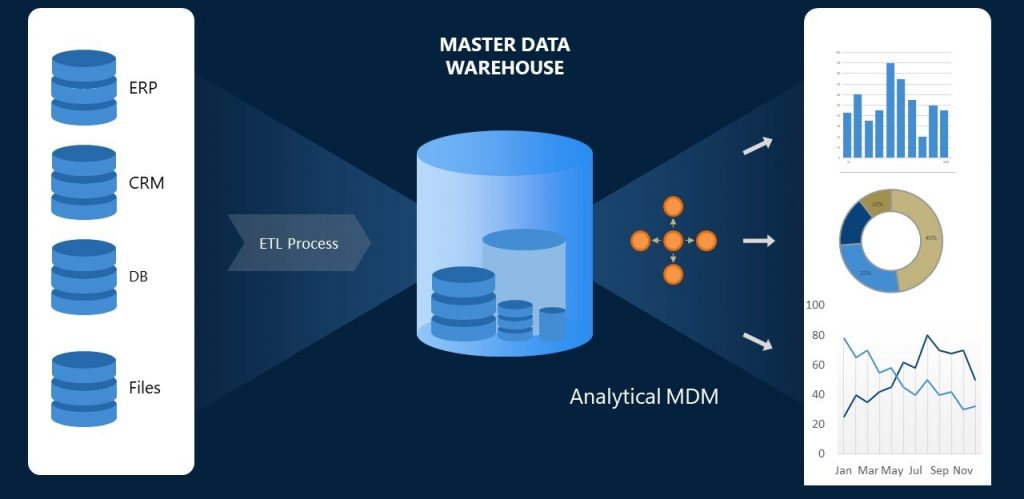
Master Data Warehousing solutions implement Analytical MDM: for
revenue generation strategic decisions. Operational MDM is more challenging and
addresses Operational Efficiencies for cost reduction as well as risk
mitigations. As highlighted in the article,
there two complementary approaches for Operational MDM: the traditional
bottom-up MDM approach and the more recent top-down Value Stream MDM approach. Data
Warehouses are ubiquitous and provide a top-down strategic view of the
enterprise for Analytic MDM. Enterprises prioritizing Digital Transformation
and balancing Data
and Process approaches are starting to realize the advantages of the more
efficient Value Stream MDM approach.
Blockchain for inter-Enterprise MDM

The examples above highlighted the challenges and approaches for
intra-enterprise MDM. What is the relevance of Blockchain for MDM? Blockchain
is a type of a database – through quite different from traditional relational
or emerging NoSQL databases. As highlighted in the podcast, Blockchain is a
linked list of blocks that contain cryptographically secured blocks of
transactions that are immutable. Participants who do not know or trust each
other can rely on and trust the Blockchain. Unlike traditional databases that
support CRUD (Create, Read, Update, and Delete), with Blockchain, you can only
Create and Read: transactions are validated and added to the blocks in the
chain. They can be read but never deleted or updated. All transactions and
activities on the Blockchain are timestamped.
So, what is the relevance of Blockchain for MDM when we cross
organizational boundaries?
Conducting business transactions across organizational boundaries
has all the challenges of intra-enterprise silos and adds several others. Inter-Enterprise
exchanges and data sharing are marred with multiple inefficiencies: manual
forms and paperwork, error-prone replications, delays due to organizational or bureaucratic
inefficiencies, errors in language translations, especially cross-country
exchanges, difficulties, and challenges in reconciling governance policies – to
name a few.
Inter-Enterprise Single Version of the Truth
The objective of MDM is to have a single version of the
truth. The truth could pertain to an asset such as a Customer or Product or Service
or any other enterprise entity. Assets could be physical or digital. A physical
asset can also have a digital twin with a unique identifier that represents the
physical asset.
Different enterprises could be partners, collaborators, competitors,
or coopetitors. They need to share information. Often the sharing of
information is marred by delays, errors, waste, potential fraud, difficulties
in tracking, and overall inefficiencies.
Blockchain is no panacea, but it can address many of these
inter-enterprise challenges through becoming a master data of information about
either an asset or a transaction involving multiple parties. The beauty of
Blockchain is the fact that no one enterprise or party owns the Blockchain. In
this sense, it is similar to the Internet: no one centralized organization owns
it.
Blockchain for Master KYC
Let us illustrate this through an example. Know Your Customer
(KYC) is a process by the government regulators that banks and financial
institutions must follow to verify the identity of the customers. They must be
verified before the account becomes effective. It can take from several hours
to several days, and the customer needs to provide official identification and
other documentation for validation. Now here is the exciting part. If a
customer opens an account in, say, one bank and then wants to open another in a
different financial organization that also requires KYC, they must go through
the process again. Blockchain alleviates this need by allowing even potentially
competing financial institutions to share KYC information for their customers.
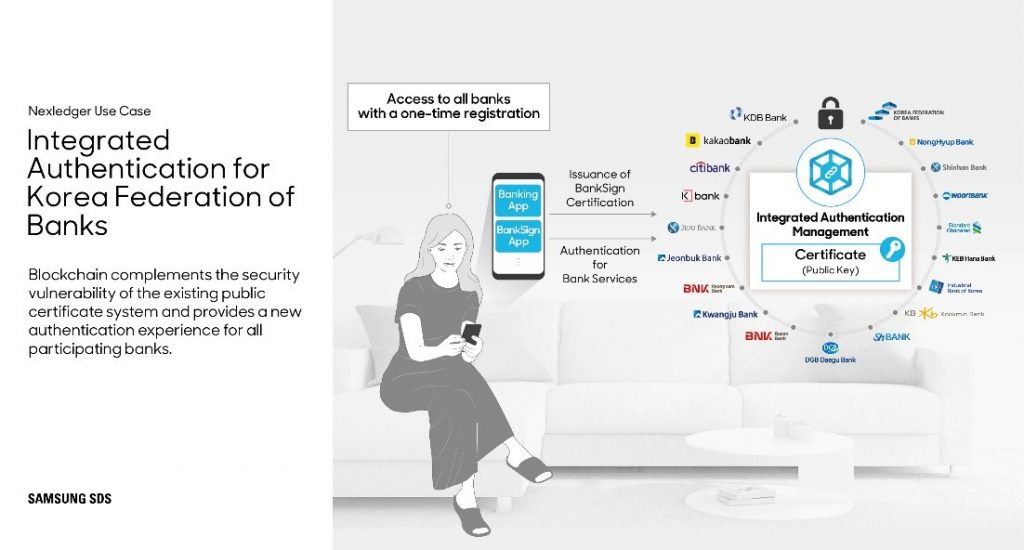
For example, Samsung’s
Nexleger Blockchain platform has been used by a consortium of Korean Banks
to share customer identity. Once the customer is validated through one bank,
they can easily be validated by other participating banks, using the Customer
identity on the Blockchain. Traditional third-party KYC approaches are
inefficient and wasteful: they require the entire identity verification process
for each new bank account. The Blockchain approach is a much more efficient and
decentralized solution. So, through a mobile application, the customer can have
access to all the banks in the participating Korean Federation of Banks.
Another huge potential area for Blockchain is recording
Vehicle Identification, processing the Registration, and the history of a
vehicle on the Blockchain. The Blockchain entries can identify assets. They
also contain the ownership history as well as entries for recalls, issues, or
accidents. If these records are all on a Blockchain, it can potentially make it
much easier to, for instance, register an out-of-state vehicle in a new state.
Furthermore, instead of relying on third-party centralized, all interested and
authorized parties can quickly gain access to the history of the vehicle. If
combined with connected vehicle tracking, the possibilities are endless. The
Blockchain can store the entire history not only of the ownership of the
vehicle, significant events such as accidents, reports, or problems, but also
the driving and maintenance history.
Blockchain for Master Vehicle Identification, Registration, and History
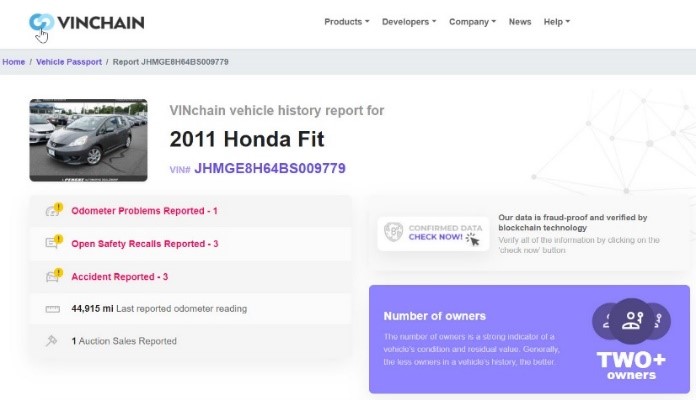
One company that is doing this is VINchain. Here is a 2011 Honda example from
their website. The Blockchain stores the master information and transaction
about the vehicle with the given VIN. All interested parties share the master Blockchain:
OEM manufacturers, distributors, dealers, owners, mechanics, DMVs, and so on.
Blockchain for The Extended Enterprise
To appreciate the relevance of Blockchain, we need to expand upon extended
enterprises as well as value streams that cross organizational
boundaries.
According to Wikipedia, “Extended Enterprise” is a “loosely coupled, self-organizing network of firms that
combine their economic output to provide products and services offerings
to the market.” Cooperating and (even sometimes competing) extended enterprises
can benefit from a single view of the truth for the various assets (such as
Customers or Products) and transactions that cross organizational boundaries. Blockchain,
as a decentralized and distributed database, can provide the foundation of
robust Extended Enterprise Master Data.
As highlighted
in “3 Technologies Powering the Autonomic Enterprise,” the extended
enterprise can potentially self-optimize and self-heal at a much faster speed
by carrying out autonomous enterprise decisions with Blockchain smart contracts
executing autonomic policies. Autonomy is achieved through end-to-end Value Streams,
empowered through blockchains as needed. Blockchain enables robust peer-to-peer
infrastructure for secure and reliable master data. Furthermore, the single
version of the truth can include policies, business rules, or contracts that
execute in the Blockchain and are shared by all participants.
Blockchain for Supply Chain MDM
Supply Chain is the quintessential Extended Enterprise
application domain. Interestingly Supply Chain is also touted as an ideal
use-case for Blockchain technologies. Blockchain can be a promising backbone for Supply Chain through several essential
categories of exchanges or flows: contractual flow, logistics (movement of
goods and material) flow, proper documentation flow, and of course, is the
foundation of cryptocurrency, the financial transaction flow. The Covid-19
pandemic highlighted the vulnerabilities in supply chains, as warehouses and
retail stores ran out of popular items in high demand.

Blockchain allows visibility and traceability of the
inventories of the needed supplies. Enterprises can trace and track the
documentation and financial transaction. Compared to traditional manual and
error-prone approaches, the shared masted information becomes much more
accessible. The digitally extended enterprise can use all parts, products,
suppliers, warehouses, inventory, documentation, tracing, and financial transaction
masters stored on the Blockchain to function as an efficient and optimized
pipeline. Supply Chains leveraging Blockchain master data and information are
applicable in all industries, and there are various innovative initiatives,
projects, and solutions that have demonstrated the compelling value proposition
for Blockchain for Supply Chain.
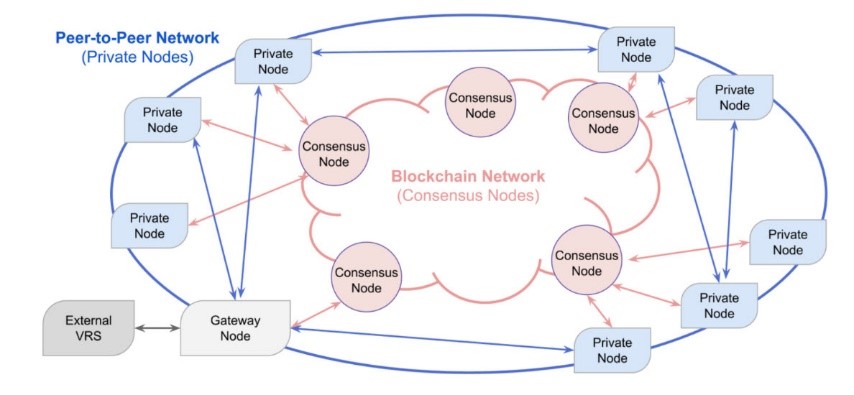
For instance, the MediLedger project started in 2017 to
leverage Blockchain specifically for the Drug Supply Chain Security Act (DSCSA).
Tracking and tracing pharmaceutical drugs is critical in the Covid-19 era. Leveraging
the Blockchain as a master for drug verification is one of the essential areas
addressed by MediLedger. The following illustrates the interaction of the participating
companies in the FDA pilot request DSCSA project. The Private Nodes of the
participants can communicate with each other (peer-to-peer) and share data with
their Consensus Node. These Consensus Nodes contain the shared Blockchain
master data shared by all the participants. As the MediLedger DSCSA Pilot Final
Report indicates: “With such a network, we can create the capability of
storing records of transactions on the Blockchain while allowing the exchange
of electronic data, just as companies are
expected to do today
with the implementation of EPCIS messages.”
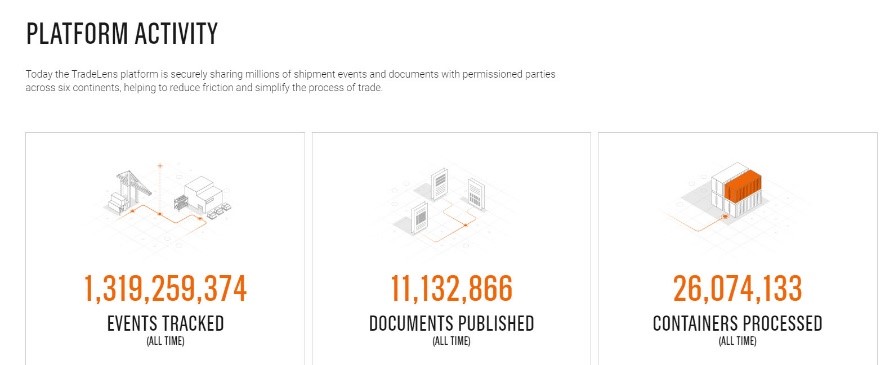
It gets even more exciting and compelling when the supply chain crosses international borders and involves various country-specific logistical regulatory and financial documents that need to be processed. The IBM-Maersk cross-border shipping Blockchain solution is a compelling text-book example of Blockchain for Supply Chain master data. Maersk had done a study in 2014 tracing roses and avocadoes from Kenya to the Netherlands. The study identified several inefficiencies. As noted in the BloombergQuint article: “The company found that almost 30 people and organizations were involved in processing the box on its journey to Europe. The shipment took about 34 days to get from the farm to the retailers, including ten days waiting for documents to be processed. One of the critical documents went missing, only to be found later amid a pile of paper.” The Blockchain solution can digitize the documents and track the shipments, resulting in substantial savings. Maersk and IBM have launched the TradeLens Blockchain-enabled platform that is addressing precisely the inefficiencies of legacy and manual container logistics. Here are some recent stats of the TradeLens platform.
Master Data Management is critical. Enterprises need a
single view of their customers, suppliers, employees, partners, or any other
entity for their data warehouses and operations. While there are bottom-up as
well as top-down solutions for intra-Enterprise MDM, the inter-Enterprise
single view is much more challenging.
Conclusions
It gets even more compelling for extended enterprises
involving trading partners in different countries. There is the added
consideration of government agency requirements, international regulations, and
tracking across borders. However, still, Blockchain is relatively immature, and
its acceptance in end-to-end applications such as master data for Supply Chains
will take a while. There are many exciting POCs and Pilots. A recent study by Gartner
predicts 80% of Supply Chain Blockchain initiatives will be pilot projects
through 2022. Despite the immaturity and challenges of Blockchain, we are
starting to see deployments in production.
The move from legacy systems, manual paper-based
documentation, and entrenched peer-to-peer protocols to a modern decentralized
Blockchain will not be smooth. But it is essential, and there is no other
technology on the horizon that is decentralized, fault-tolerant, secure, and reliable
for inter-Enterprise Master Data Management.
The potential of Blockchain for MDM is vast.
